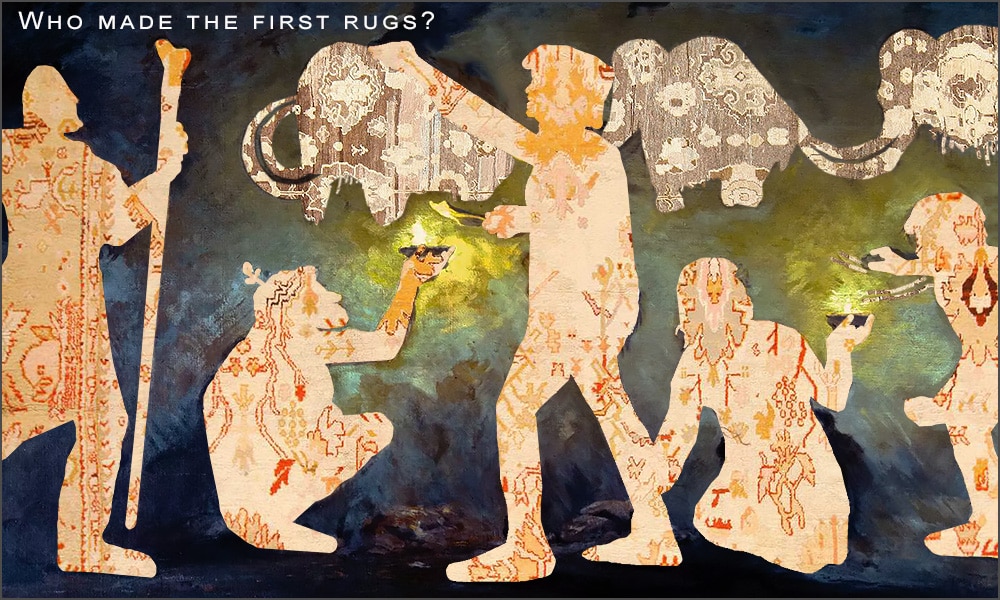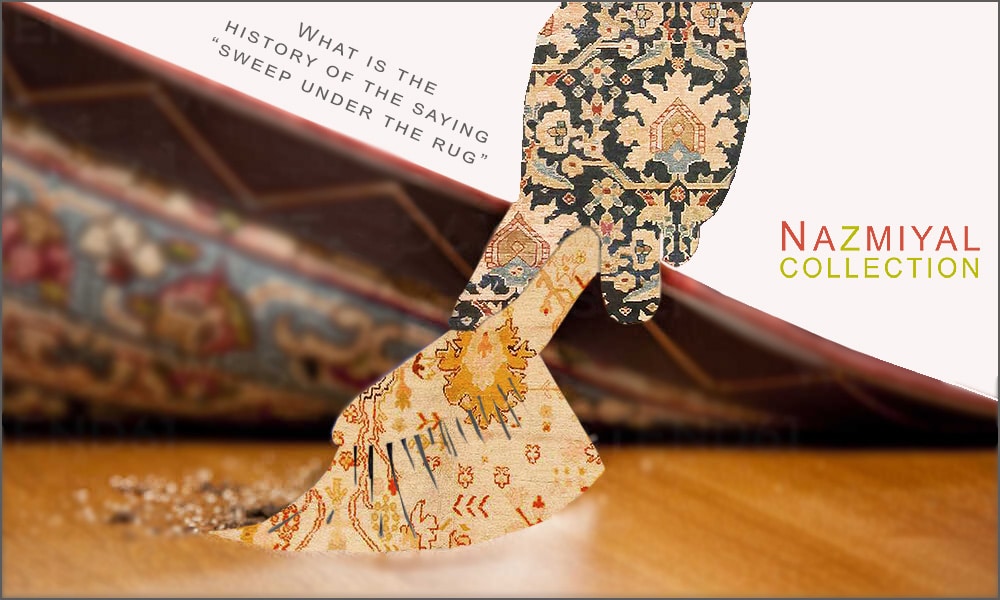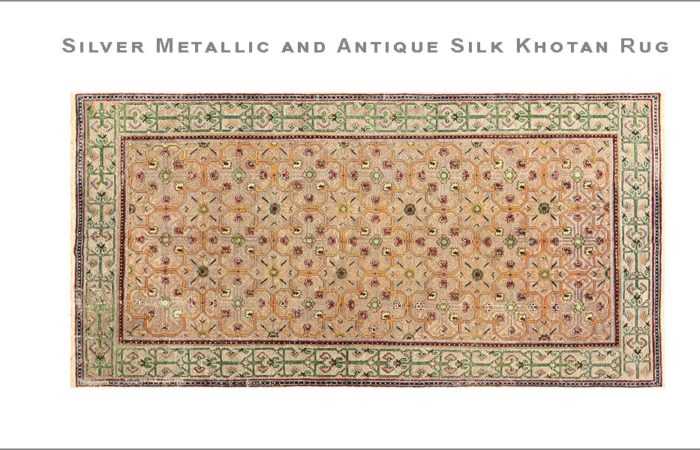Just for fun – here are some fun rug facts
Shop Antique Rugs | Shop Vintage Rugs | Shop Modern Rugs
Lets review some of the more asked about rug facts
Who made the first rug?
Nomadic tribes have been weaving rugs for over 5,000 years. That said, the exact origin of the first rug is difficult to determine with certainty as rugs have been made, woven and used by various cultures throughout history. However, the practice of weaving textiles and rugs dates back thousands of years, and area rugs have been an integral part of human civilization for a long time.
The earliest known example of a rug was discovered in an archeological dig in the Pazyryk valley. The “Pazyryk carpet” is a well-preserved early rug dating back to the 5th century BCE. It was discovered in the Pazyryk burial mounds in Siberia.
Rug making also has a long history in ancient Persia (modern-day Iran), where it has been practiced for thousands of years. Persian rugs are renowned for their intricate designs and skilled craftsmanship.

Who made the first rugs?
It’s important to note that the art of rug making likely developed independently in different regions around the world as various cultures sought to create functional and decorative floor coverings. Therefore, it is challenging to attribute the invention of the first rug to a single individual or culture.
You should read our area rug guide to learn more about the history of Oriental rugs
What is the origin of the word “rug”?
The word “rug” has its origin in the Scandinavian languages. It is derived from the Old Norse word “rokk” or “rokkr,” which referred to a coarse cover or blanket. This term eventually evolved into “rugge” in Middle English, which denoted a coarse, shaggy fabric used for bedding or floor covering.
What does the word rug actually mean?
Over time, the term “rug” came to represent a thick fabric or textile used to cover the floor, providing warmth and comfort. The word “rug” is now widely used in English to refer to a floor covering that is typically smaller than a carpet and is often used in specific areas of a room.
What is the origin of the word carpet?
The word “carpet” has its origins in the Old French word “carpite” or “carpette,” which was derived from the Latin word “carpere,” meaning “to pluck” or “to card.” Originally, “carpite” referred to a thick fabric used for table coverings or bedspreads – kind of like quilts. Over time, the term expanded to include floor coverings as well.
The association of the word “carpet” with floor coverings became more prominent during the medieval period in Europe. Carpets were woven textiles that were often used to cover floors and provide insulation and comfort. As trade and cultural exchanges expanded, carpets from the Middle East, particularly from Persia (modern-day Iran), became highly sought after and influenced the development of the European carpet-making industry.
The word “carpet” gradually entered the English language, and it has been used to refer to floor coverings. Many times the word “carpet” is used to refer to wall-to-wall carpeting as well as to refer to larger size area rugs. Today, “carpet” is a widely recognized term used to describe a soft, woven floor covering that is often permanently installed in a room or that is larger than a small scatter size rug.
What are some funny quotes about rugs?
- “I have a rug fetish. Rugs make me happy.” – Ellen DeGeneres
- “The rug really tied the room together, did it not?” – Jeff Bridges AKA “The Dude” in the movie “The Big Lebowski”
- “When someone beats a rug, the blows are not against the rug, but against the dust in it” – Rumi
- “What if everything is an illusion and nothing exists? In that case, I definitely overpaid for my carpet. If only God would give me some clear sign! Like making a large deposit in my name at a Swiss bank.” ― Woody Allen, Without Feathers
- “The chances of an open-faced jelly sandwich landing face down on a floor, are directly correlated to the newness & cost of the carpet or rug.” – Law of Physical Surfaces – Murphy’s Laws

Big Lebowski – Rugs Really Tie The Room Together
You may want to also read: Rugs Really Tie The Room Together | Some Of Our Most Favorite Movie Rugs
What is the history of the saying “snug as a bug in a rug”?
English actor David Garrick’s is credited with coining the expression is regards to the celebration of Shakespeare’s Stratford Jubilee in 1769 saying:
“If she [a rich widow] has the mopus’s [coins or money], I’ll have her, as snug as a bug in a rug.”
The meaning of saying “snug as a bug in a rug” is a playful and rhyming expression used to describe someone who is comfortably and snugly settled in a particular place or situation. The origin of this phrase is not precisely known, but it is believed to have emerged in the late 18th or early 19th century.
The expression likely arose from the observation that bugs or insects could seek warmth and shelter by hiding under a rug or carpet. Bugs that found their way beneath a rug would be protected from the elements and snugly nestled in the fabric, creating a sense of coziness and security.
The phrase gained popularity over time due to its catchy and rhythmic nature. It has been used in literature, poetry, and everyday language to convey a sense of comfort and contentment. Today, “snug as a bug in a rug” is often used in a lighthearted manner to describe someone who is feeling perfectly comfortable and at ease in a particular situation or location.
What is the history of the saying “sweep under the rug”?
Today, the saying “sweep under the rug” is an idiomatic expression that means to conceal or hide something, especially a problem or an issue, instead of addressing it directly. The origin of this phrase is not really known but it can be traced back to the (laziness) act of physically sweeping dirt or debris under a rug or carpet to hide it from view.
Rugs or carpets have been used for centuries to cover floors and provide warmth and comfort. In earlier times, when cleanliness and sanitation were not as advanced as today, dirt, dust, and debris would accumulate on the floors. To quickly clean a room or hide the mess, people would sweep the dirt under the rug, effectively concealing it from sight.

What IS The History Of The Saying – Sweep Under The Rug?
Metaphorically, the act of “sweeping under the rug” came to represent avoiding or ignoring a problem, rather than addressing it directly. It suggests an attempt to hide or cover up an issue rather than dealing with it openly. The saying has become a common metaphor in many languages and cultures, highlighting the concept of avoiding confrontation or disregarding problems.
What was the first chemical dye?
The Polish chemist and banker, Jakub Natanson, created the first chemical carpet dye in 1856 which is called “Fuchsine”. This dye started being used in the rug industry around the years 1863 and initially it was mostly used throughout the Caucasus region.
Did cleopatra really roll out of a rug?
The story of Cleopatra rolling out of a rug is a popular legend, but it is highly unlikely to be historically accurate. The notion that Cleopatra used a rolled-up rug to enter the presence of Julius Caesar or Mark Antony is primarily based on fictionalized accounts and dramatizations rather than historical evidence.
The most well-known version of this tale comes from the works of the Roman historian Plutarch, who lived several centuries after Cleopatra. According to Plutarch, Cleopatra concealed herself inside a rolled-up rug or carpet and was presented to Julius Caesar as a gift. However, Plutarch did not provide any sources for this anecdote, and it is widely regarded as a literary device to depict Cleopatra’s cunning and resourcefulness.

1866 Jean Leon Gerome Painting Of Cleopatra and Caesar
It is important to note that historical accounts of Cleopatra’s life, primarily from ancient Roman sources, do not mention such an incident. Cleopatra was renowned for her intelligence, political acumen, and persuasive skills rather than using deceptive tactics like hiding in a rug.
While the rug story of Cleopatra rolling out of a rug has captured the popular imagination and has been depicted in various movie films, plays, and literature, it should be understood as a fictionalized element rather than an established historical event.
When were the first machine made rugs made?
The production of machine-made rugs began in the late 18th century with the invention of the power loom. However, it wasn’t until the 19th century that the machine-made rug industry experienced significant growth and development.
The first notable advancements in machine-made rugs took place in the early 19th century in Europe and the USA. In 1801, John Heathcoat patented the Willesden carpet loom in England, which mechanized the process of weaving carpets. This innovation allowed for faster and more efficient production of carpets.
In the United States, Erastus Bigelow made significant contributions to the machine-made rug industry. In 1839, Bigelow patented the power loom for weaving ingrain carpets, which further improved the speed and quality of rug production.
As the 19th century progressed, advancements in technology and industrialization led to further improvements in machine-made rug production. The introduction of Jacquard looms, which allowed for complex and intricate designs, played a crucial role in expanding the capabilities of machine-made rugs.
Machine-made rugs became more widespread and affordable during the late 19th and early 20th centuries, thanks to advancements in mass production techniques. Synthetic fibers such as nylon and polyester were later introduced, further diversifying the options available in machine-made rugs.
Hope you enjoyed this post about fun and interesting area rug facts. You should also review our most frequently asked rug related questions. But, if we missed anything that you would like to know then simply contact us.
This rug blog that talks about fun and interesting facts about area rugs and carpets was published by Nazmiyal Rugs



